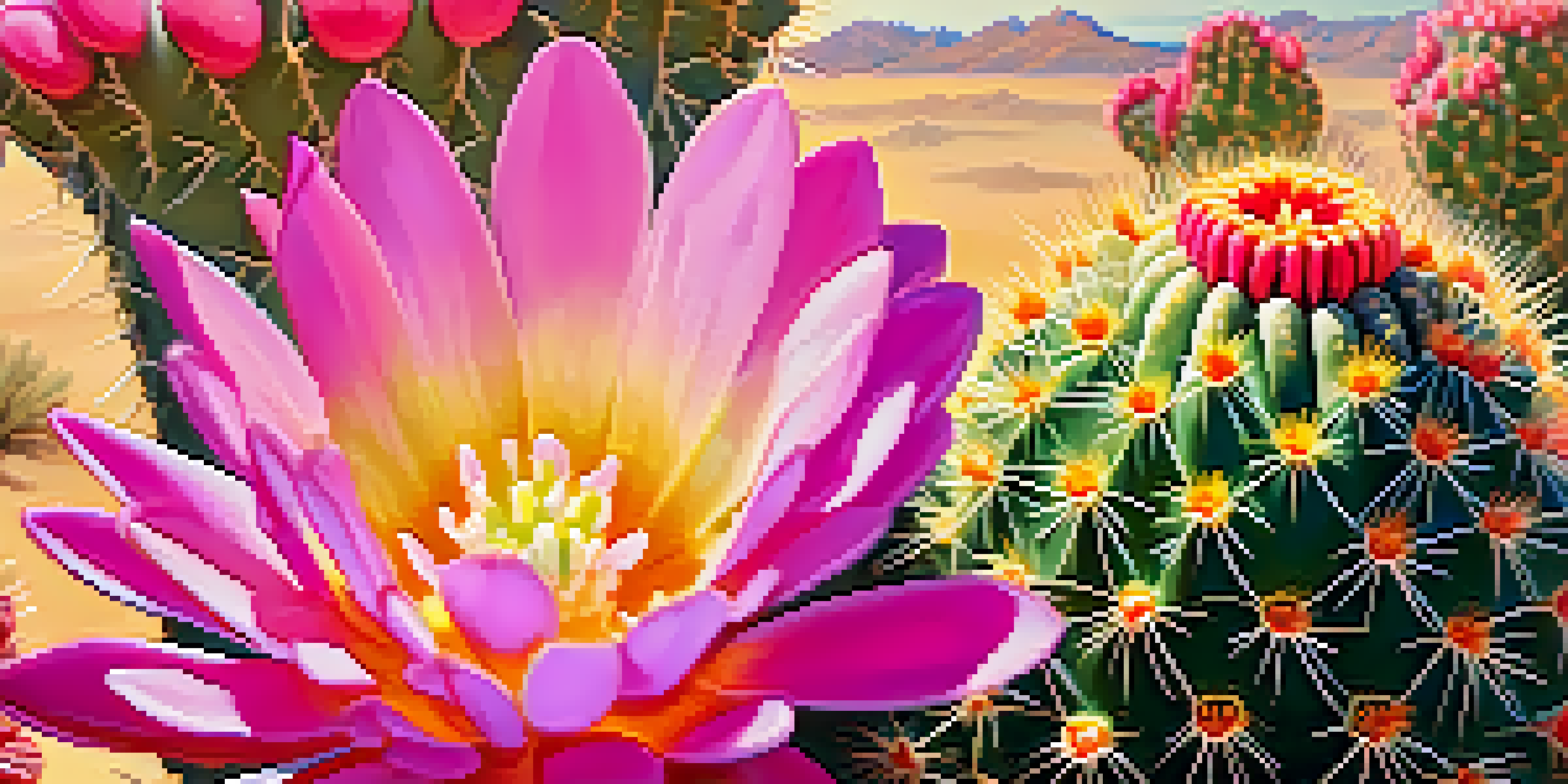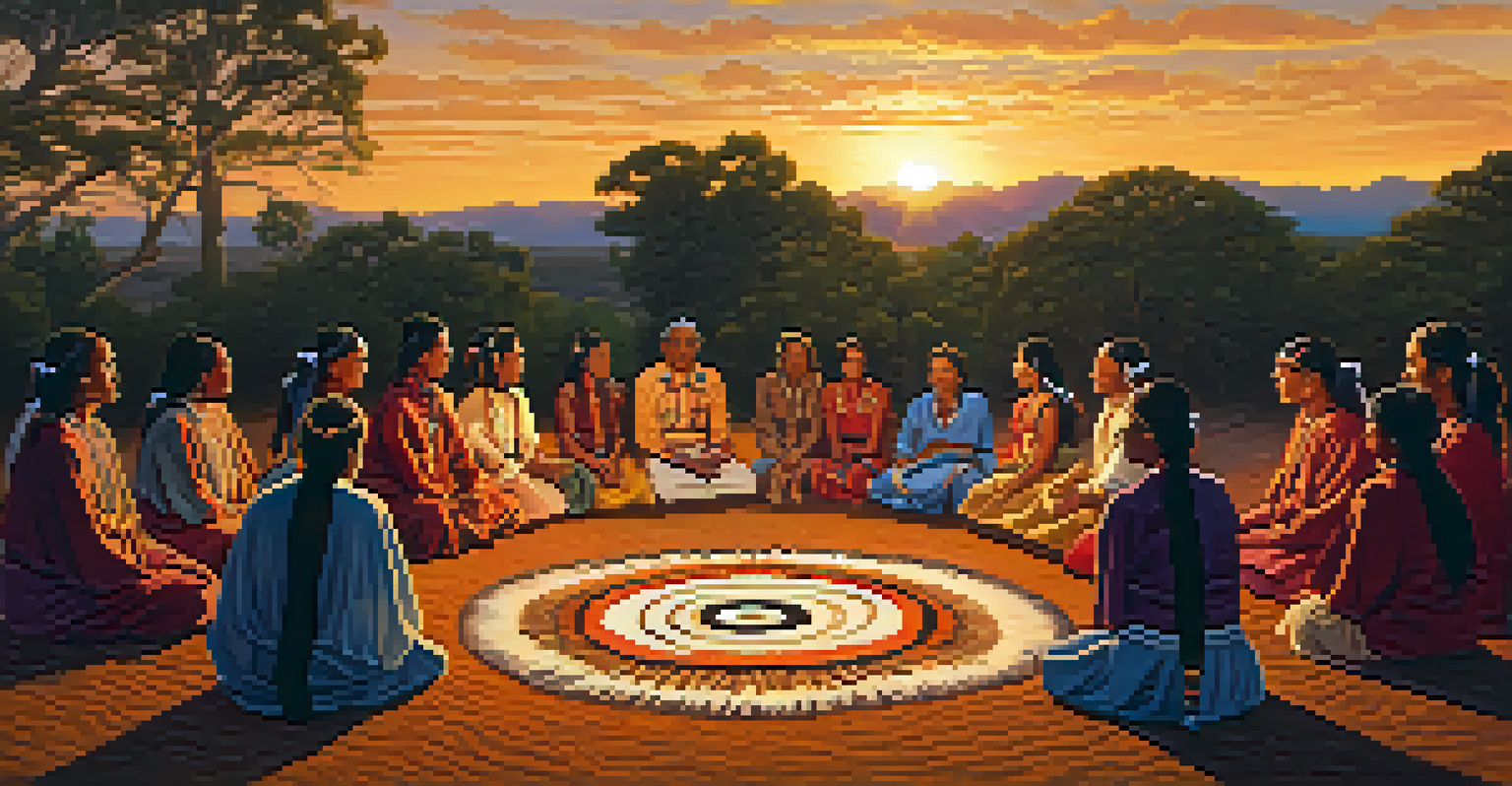Peyote's Role in the Colonial Encounters with Indigenous Peoples

Understanding Peyote: A Sacred Plant for Indigenous Peoples
Peyote, a small cactus known scientifically as Lophophora williamsii, has been a central element in various Indigenous cultures, particularly among Native American tribes. For many, it's more than just a plant; it's a spiritual ally, used in rituals and ceremonies to connect with the divine. The psychoactive properties of peyote, primarily due to the compound mescaline, facilitate profound spiritual experiences and insights.
The plant (peyote) is a sacred medicine that helps us to connect with the Creator and the spirit world.
In these traditional contexts, peyote is often consumed during religious ceremonies, where it serves as a catalyst for healing and introspection. Indigenous peoples regard this cactus as a gift from the Creator, emphasizing its role in fostering community bonds and spiritual well-being. Thus, peyote's significance transcends its physical presence, embedding itself deeply within cultural identity and practice.
However, the arrival of European colonizers introduced a multitude of challenges to these Indigenous practices. The colonial mindset often dismissed or misunderstood the spiritual significance of peyote, leading to conflicts that would alter the relationship between Indigenous peoples and their sacred traditions.
Colonial Encounters: Misunderstanding and Conflict
When European colonizers first encountered Indigenous peoples, they often misinterpreted their customs, including the use of peyote. The spiritual rituals surrounding peyote were frequently labeled as 'savage' or 'primitive,' reflecting a broader colonial attitude that devalued Indigenous cultures. This miscommunication led to increased tensions and a lack of respect for Indigenous spiritual practices.

Furthermore, these misunderstandings often resulted in direct conflict. Colonizers imposed their own beliefs and practices, undermining Indigenous sovereignty and forcing many communities to adapt or abandon their traditional ways. As peyote was integral to many of these practices, its use became a focal point in the struggle between Indigenous peoples and colonial powers.
Peyote: A Sacred Indigenous Plant
Peyote serves as a spiritual ally for Indigenous peoples, facilitating profound experiences and community bonding.
The colonial era also saw the criminalization of peyote use, as it was often associated with Indigenous resistance. The act of consuming peyote was framed as a threat to colonial authority, further exacerbating the divide between cultures and leading to the marginalization of Indigenous spiritual practices.
Peyote and the Development of Indigenous Identity
Despite the challenges posed by colonial encounters, peyote emerged as a symbol of resilience and cultural identity for many Indigenous communities. The struggle to maintain traditional practices, including the use of peyote, became a means of asserting their identity and resisting colonial oppression. In this way, peyote transcended its role as a mere plant, becoming a potent symbol of survival and cultural pride.
Our sacred traditions are not mere relics of the past, but living practices that define our identity and resistance.
Throughout the 19th and 20th centuries, the peyote religion began to formalize as a response to colonial pressures. Groups such as the Native American Church were formed, providing a framework for the spiritual use of peyote that combined traditional beliefs with new adaptations. This evolution highlighted the adaptability of Indigenous cultures, demonstrating how they can innovate while remaining rooted in their heritage.
As peyote rituals became more organized, they fostered a sense of unity among diverse Indigenous groups. This shared experience not only reinforced cultural ties but also provided a platform for collective activism against colonial injustices, showcasing the plant's role in both spiritual and political realms.
Legal Challenges and the Fight for Peyote Rights
In the mid-20th century, peyote faced significant legal challenges as governments sought to regulate or prohibit its use. This led to a series of court cases that highlighted the tension between Indigenous religious freedom and state laws. Many Indigenous advocates argued that the use of peyote was a fundamental part of their spiritual practices and should be protected under religious freedom laws.
One landmark case involved the Native American Church, which fought for the right to use peyote in ceremonies. The legal battles underscored the broader struggle for Indigenous sovereignty and self-determination in the face of colonial legacies. These efforts ultimately led to some legal protections for peyote use, although challenges remain.
Colonial Misunderstandings Persist
The arrival of European colonizers led to conflicts and the criminalization of peyote, disrupting Indigenous spiritual practices.
Today, the fight for peyote rights continues, with advocates emphasizing the need to respect Indigenous traditions and autonomy. This ongoing struggle serves as a reminder of the complex relationship between colonial powers and Indigenous peoples, highlighting the importance of legal recognition and support for traditional practices.
Modern Perspectives: Peyote in Contemporary Indigenous Cultures
In recent years, there has been a resurgence of interest in peyote among Indigenous communities, as younger generations seek to reconnect with their cultural heritage. This revival is not just about the plant itself but also about reclaiming identity and traditions that colonial forces tried to erase. Many modern ceremonies incorporate peyote, illustrating its continued relevance in spiritual and communal contexts.
Additionally, the contemporary conversation around peyote has expanded to include discussions about sustainability and environmental impact. As demand for peyote grows, there are concerns about overharvesting and the long-term viability of this sacred plant. Indigenous leaders are advocating for responsible practices that honor both the plant and the traditions surrounding its use.
Moreover, the broader society is beginning to recognize the importance of peyote in Indigenous cultures, leading to greater respect and understanding. This shift offers an opportunity for dialogue between Indigenous and non-Indigenous communities, fostering mutual respect and collaboration in preserving these vital cultural practices.
Peyote and Intercultural Dialogue
The story of peyote is not just one of Indigenous struggle; it's also a narrative of intercultural dialogue and understanding. As more people learn about the significance of peyote to Indigenous cultures, there is potential for increased respect and collaboration. This dialogue can help bridge gaps between Indigenous and non-Indigenous communities, fostering a shared appreciation for cultural diversity.
Educational initiatives, cultural exchanges, and community events focused on peyote can serve as platforms for this dialogue. By sharing knowledge and experiences, participants can gain insights into the rich spiritual traditions that surround peyote, creating a more inclusive understanding of its importance. Such initiatives can also help combat stereotypes and misconceptions that have persisted since the colonial era.
Peyote's Role in Cultural Resilience
Despite legal challenges, peyote symbolizes cultural identity and resistance for Indigenous communities, fostering unity and activism.
Ultimately, fostering intercultural dialogue is essential for healing the wounds of colonialism. By recognizing and respecting the role of peyote in Indigenous cultures, society can move toward a more equitable future where diverse cultural practices are celebrated and preserved.
Conclusion: Peyote's Enduring Legacy
Peyote's journey through colonial encounters exemplifies the resilience of Indigenous cultures in the face of adversity. Despite centuries of misunderstanding, conflict, and legal challenges, peyote remains a vital part of many Indigenous identities. Its role as a spiritual catalyst continues to inspire and unite communities, reinforcing the significance of cultural heritage.
As society becomes more aware of the historical and contemporary significance of peyote, it also opens the door for greater advocacy and support for Indigenous rights. This recognition is crucial for ensuring that traditional practices are honored and preserved for future generations. It highlights the importance of respecting Indigenous sovereignty and the cultural practices that define their identities.

In conclusion, peyote is not just a plant; it's a symbol of resilience, identity, and the ongoing struggle for Indigenous rights. Its enduring legacy serves as a call to action for all of us to engage in meaningful dialogue and support the preservation of diverse cultural traditions.